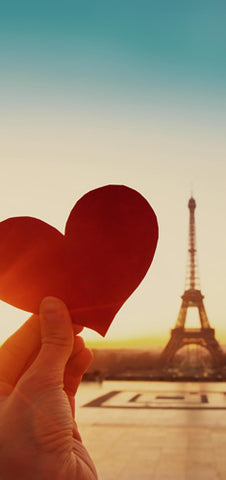The Normandy region of France combines a 360-mile coastline, including the dramatically evocative World War II landing beaches, with a verdant interior of lush farmland, bustling market towns, and historic landmarks such as the cities of Caen, Bayeux and Rouen. Gastronomic delights abound, from fine cheeses to cider and Calvados.
A few quick facts about Normandy: That pat of butter on your plate in a Paris restaurant is almost certainly from Normandy. The port of Le Havre is France’s largest international shipping port, though in the 19th century, European immigrants to America always sailed out of Cherbourg. 300,000 troops landed on June 6, 1944 for the Normandy invasion which spelled the beginning of the end for World War II in Europe.
Below are some highlights of this dynamic and historic region of France.
The D-Day Landing Beaches: The largest military landing in history took place in Normandy on June 6, 1944. Monuments, museums, bunkers and cemeteries are a living commemoration to the Battle of Normandy. A perfect base from which to tour the beaches was the first town liberated by the Allies: the historic town of Bayeux. Built around the magnificent Cathedral of Notre-Dame, it is home to the 200-foot long Bayeux Tapestry, a world famous masterpiece of embroidery whose vivid scenes depict the epic tale of William the Conqueror's expedition to England in the 11th century.

We offer four ways to visit Normandy
American Normandy D-Day Tour from Paris
D-Day Tour with Overnight in Bayeux and Mont St. Michel
Custom and Private Normandy D-Day Tours
Mont Saint Michel day trip
Caen War Memorial: The Caen Memorial continues a visitor's journey through the 20th century, from the second World War to the world at the time of the Cold War. Exhibits offer thoughtful commentary about peace and the future of war. The museum is a good starting point for local touring, reminding the visitor of the complicated and extensive political origins of the second World War.
Giverny: During a fateful train ride, Claude Monet spotted this small village along the Seine, 50 miles from Paris, and vowed to live there. By 1890 he had bought the land and home memorialized in so many of his paintings, particularly the water lily series. Today, art lovers take the train to Vernon and a short bus ride to see the house gardens, open from April to October. Also locally, visitors can see the colony of houses occupied by American Impressionist painters of the mid 19th century and an excellent local museum featuring rare Impressionist works.

Rouen: A thriving industrial and commercial center and the third largest port in France, Rouen is steeped in history. Both William the Conqueror and Joan of Arc died in the town Victor Hugo called "the city of a hundred spires". Rouen is home to many museums as well as the Gothic Cathedral of Notre-Dame, immortalized by French Impressionist Claude Monet.
Bayeux Tapestry: Tapisserie de Bayeux (Bayeux Tapestry) more info. This world-famous Medieval masterpiece, dating back to 1060 a.d., depicts the epic story of the conquest of England by William the Conqueror.
Dieppe/Fecamp/Etretat: As the oldest seaside resort in France, Dieppe has something for everyone. Its history is retold in the castle museum. The Benedictine Palace & Museum, home of the famous Benedictine liqueur, is Fécamp's main claim to fame. Also, don't miss its picturesque marina. A short drive down the coast lies the village of Etretat, nestled between striking white cliffs.

Deauville/Trouville: Driving along the "Flowered Coast", three picture perfect towns stand out: the glamorous resort town of Deauville, home to the rich and famous (and a film festival), is a thriving vacation spot of luxury hotels, casinos, race tracks, golf courses and polo grounds. Its twin city, Trouville, separated from Deauville by the Touques river, is a more sedate fishing village. Both towns boast wide sandy beaches. Further along the coast you find Honfleur, considered the birthplace of impressionist painting. This charming harbor village, with narrow timbered houses dates from the 11th century, and has always attracted artists, among them Monet and the poet Baudelaire.

Alencon/Haras du Pin/Bagnole de L'Orne: A discovery of Normandy would be incomplete without a mention of this region's passion for horses, Tourists are welcome to attend any of the numerous horse shows and competitions and visit the many horse breeding estates, of which the Haras du Pin, or the "Versailles of horses", is the most exceptional. Alencon's Fine Arts and Lace Museum presents a major collection of French and European lace from the 17th to the 20th century. Bagnoles de l'Orne, a premier spa center, is also worth a visit.
Mont Saint Michel: The enchanting Abbey of Mont-St-Michel is perched precariously on a 264-foot high rocky islet connected to mainland France by a causeway. Surrounded by over half a mile of massive walls and reached by a steep climb up winding streets, it remains one of the greatest sightseeing attractions in Europe and the second most visited place in France after the Eiffel Tower. Mont St. Michel is also known for its tides, the highest on the continent, which race towards the isle at the speed of "galloping horses". Visit Mont St. Michel with a one day trip from Paris.
A priest's repeated dreams of St. Michael led to the multi-century building of the monastery and town below; the monastery to this day holds daily masses in Latin.

American Art museum of Giverny: The American art museum of Giverny will give you a global understanding of the work of the American artists that came to France at the end of 19th century to study and work on painting. Visit giverny.org
Upper Normandy - Just across the Channel from London and not very far from Paris, you will find the welcoming region of Normandy with its varied coastline and rich countryside. 600 kilometers of contrasting seaside with cliffs, pebbly coves and long stretches of golden sands make it an attractive destination for the holidaymaker. Family resorts along the Cherbourg peninsula and the whole coastline are warmed by the Gulf Stream. Deauville, Trouville, and Cabourg are well established and desirable seaside places.
Inland, magnificent forests, tranquil streams flowing lazily through rich agricultural countryside and apple orchards are the hallmark of this sedate and fruit producing region.
Excursions include the Cider Road and the Cheese Road. And if the pace is too fast by car, you can hire a horse drawn carriage. In every corner, you will discover hidden treasures : the pretty harbor of Honfleur, the Bayeux Tapestry, William the Conqueror's birthplace at Falaise, the basilica at Lisieux dedicated to Saint Theresa, Claude Monet's treasured garden at Giverny, and the world-famous Mont Saint Michel, with its breathtaking views from the ramparts.
Normandy is a rich gastronomic area with its fresh fish ("when Dover soles cross the Channel, they arrive in Dieppe") and shellfish, duck, cream and, of course, the famous Calvados and cheeses like Camenbert, Livarot, and Pont l'Eveque.
Getting to Normandy
By train:
Direct connections from Paris to all main cities in Normandy. From St Lazare train station to Rouen, Le Havre, Caen, Deauville and Cherbourg. From Montpamasse train station to Alençon, to Mont Saint Michel (with connection).
By air:
From London, flights to Caen (Brit'Air, Flandre Air), Rouen (Flandre Air.Regional Airlines), Le Havre (Regional Airlines, Flandre Air, Brit'Air) and Deauville (BritAir).
By boat:
From England, direct connections to Caen/Ouistreham (Brittany Ferries), Cherbourg (P&O European Ferries, Brittany Ferries), and Le Havre (P&O European Ferries).
By car:
Roissy CDG airport is only 2 hours drive from Normandy
Normandy Map

Sports and Leisure in Normandy
Sea and river pleasures: Normandy is known as a port of call for many cruise lines. Stops at Le Havre are very common. From Le Havre, trips to the D-Day landing beaches, Mont St. Michel, or even Paris are possible (contact us for more details).
River cruises, and fishing excursions are also available throughout the region. Sailing and windsurfing are available at Deauville, Trouville, Fécamp and Granville among others.
Biking, Hiking and the great outdoors: Cycling is popular in Normandy especially along the coast, which is not too hilly; in the Cotentin Peninsula, with little traffic; in the rolling hills of Suisse Normande dotted with villages and picnic spots; or the Seine Valley. The Suisse Normande is also a great area for canoeing, rock climbing, and hiking. Hikers will love the Parc Regional de Normandie-Maine, Parc Regional de Brotonne, Parc Regional du Perche, or the Parc des Marais du Cotentin etdu Bessin. Normandy has ten long-distance walking itineraries and 7500 km paths with signposts as well as lots of footpaths for shorter walks.
Horseback riding is available throughout the region. Rural trails will delight and relax you. Or, take in the horse races at the prestigious Deauville racetrack. Le Pin national Stud at Haras du Pin is also worth a visit.
Golf: There are 37 golf courses in Normandy, of which 25 have 18-hole courses, including a scenic course atop a cliff near Etretat. The resort town of Deauville has four courses alone. At Le Vaudreuil, set in a park between two branches of the river Eure sits one of Normandy's most beautiful golf courses. Other sites include the Château du Champs de Bataille and Bellême.

